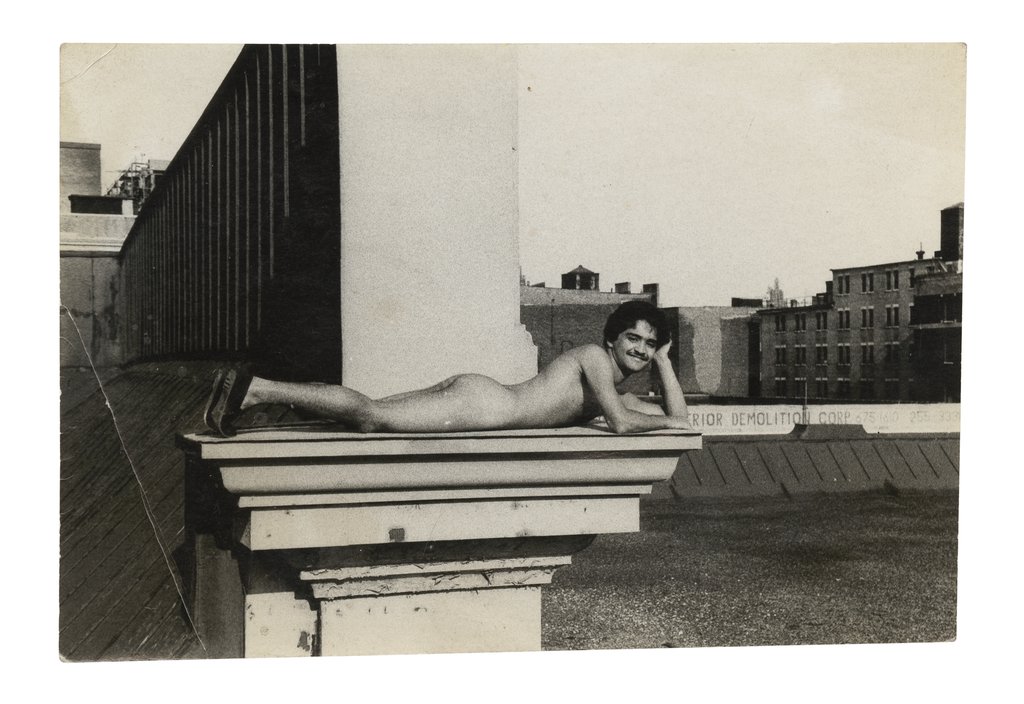
Alvin Baltrop
The Piers (man lying down on ledge)
n.d. (1975-1986)
Silver gelatin print
Image size: 2.83 x 4.13 in (7.2 x 10.5 cm)
Framed: 13.9 x 15.91 in (35.3 x 40.4 cm)
Image courtesy of Galerie Buchholz, Berlin, Cologne, and New York
Alvin Baltrop (1948-2004) was an African American Navy veteran and photographer born in the Bronx. These works are from the largest extant series of Baltrop’s photographic practice, documenting the gay social and sexual experimentation in the empty warehouses of Manhattan’s West Side piers in the 70s and 80s.
Baltrop’s images captured leisurely sunbathing, cruising, sexual acts, and crime scenes. With a sensibility to architecture, Baltrop portrayed his subjects with a heightened sense of drama, instilling his scenes with humanity. While the interest in Baltrop’s work often focuses on the libidinous atmosphere he captured, it’s important to situate that moment as pivotal in the LGBTQ community in its struggle for inclusion and civil rights.
Bronx Museum, The Life and Times of Alvin Baltrop
Baltrop began his career as a teenager shooting on the streets of New York. Early on he also photographed the patrons of the Stonewall Inn, New York’s famous gay bar, to which he and other gay teenage friends gained entry by lying about their age, prior to the famous Stonewall Riots of 1969. The energy of this downtown community clearly had an effect on Baltrop, as he would later move to the East Village and live there for nearly three decades. Unfortunately his mother, Dorothy Mae Baltrop, who was a devout Jehovah’s Witness and was often in conflict with Baltrop over his homosexuality, destroyed most of her son’s early photographs and negatives…Baltrop frequently captured people engaged in looking or someone or something else. The act of viewing is therefore compounded and overlapping.
In 1969, Baltrop entered the US Navy, where he continued photographing at sea. He later recalled: “I was just being sent to boot camp when they had the riots at Stonewall. My friends were sending clippings about it. We all used to hang out there, and now I was seeing my friends in the newspaper. I couldn’t tell anyone else about it, but after my first year in the Navy I learned that I could be a whole person… I was a medic. They called me W.D. – witch doctor. I built my developing trays out of medic trays in the sick bay; I built my own enlarger. I took notes about exposures, practiced techniques, and just kept going. I think I perfected my lighting skills there.”
In 1972, Baltrop received an honorable discharge from the Navy and returned to the Bronx. Following his brother’s example, he enrolled in the School of Visual Arts the following year on the G.I. Bill. In 1975, he began working as a taxi driver. As Weegee had done decades earlier, Baltrop used a police radio, which he hid in the vehicle, to locate crimes throughout the City that he could photograph during his breaks. It was during this time that he began to visit and take photographs at the West Side Piers…
In 1975, New York City was bankrupt…New York now had a vast supply of abandoned properties that it couldn’t even afford to tear down. The piers and their adjacent warehouses were adopted by New Yorkers for a variety of purposes. Some went there to sunbathe. Others went to engage in sexual activity. Teenage runaways, the homeless, and mentally ill went there because they had nowhere else to go. Thieves and murders also went there looking for prey. An increasing number of artists also ventured there to make art. Eventually, Baltrop quit his job as a taxi driver and purchased a van that he used in his new profession as a mover. Loading his van with cameras, film, food, wine, joints, and a handgun, Baltrop would stay at the piers for days on end, using his vehicle as a place to change clothes, eat, and sleep. In 1975, he dropped out of SVA because he could no longer juggle school, work, and his art. It was at this point that Baltrop fully committed to capturing the piers.
In 1986, the West Side Piers were finally demolished by the city, citing public health and safety concerns.
– Press release adapted from Randal Wilcox’s biography of Alvin Baltrop, Galerie Buchholz, 2021
Baltrop’s practice shares an interest in architecture and a documentary sensibility with other works in the collection such as Tom Burr’s Diana Ross Playground (1993), Larry Johnson’s Untitled (John Sex) (1999-2000) and Reynaldo Rivera’s Las Reinas de la Noche, 5 (1995).
Provenance
Galerie Buchholz
Other works by Alvin Baltrop
Alvin Baltrop, The Piers (three men on a dock), n.d. (1975-1986)
See also
Alvin Baltrop in the collection of the MoMA
Alvin Baltrop in the collection of the Whitney Museum of American Art
“Alvin Baltrop,” Galerie Buchholz, Berlin, 30 April – 3 July, 2021
Jesse Davis, “Down and Out on the West Side Piers,” Aperture, October 24, 2019
Douglas Crimp, “Alvin Baltrop: Pier Photographs, 1975-1986,” Artforum, February 2008